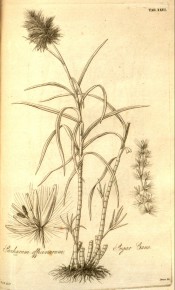Saccharum officinarum L.
Tall grass with dark green leaves. To 3m. An important economic crop, the source of cane sugar. [RHSD, Hortus].
Horticultural & Botanical History
‘This precious plant, so especially valuable in a commercial point of view, is supposed to be a native of the East Indies. The Chinese date the cultivation of the Sugar Cane to periods of the most remote antiquity: but Dr. Roxburgh ascertained that the Sugar Cane of China was different from S. officinarum, and he has published it as the S. sinense. From the East Indies it was carried by merchants, towards the close of the thirteenth century, to Arabia, whence the cultivation of it soon extended to Nubia, Egypt, and Aethiopia. The Moors introduced it into Spain. The Spaniards conveyed it to the Canaries in the beginning of the fifteenth century. From the Canaries it was imported to St. Domingo, and now forms one of the staple articles of trade of the whole of the West India Islands.’ [HBM pl.XXVI/1830].
Introduced to Britain in 1597. [JD].
History at Camden Park
Obtained from the Sydney Botanic Garden, 19th July 1847 [RBGS AB]. It seems unlikely that Macarthur expected Sugar cane to grow readily at Camden. He possibly obtained it to send to one of his northern Australian customers. Now an important commercial crop in northern Australia.
Notes
Published Feb 26, 2009 - 04:01 PM | Last updated Jul 29, 2010 - 04:55 PM
| Family | Poaceae |
|---|---|
| Category | |
| Region of origin | India to East Indies |
| Synonyms | |
| Common Name | Sugar cane |
| Name in the Camden Park Record | Saccharum officinarum |
| Confidence level | high |
